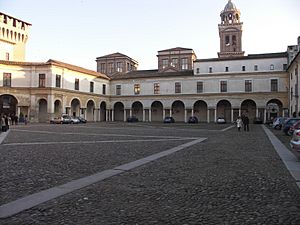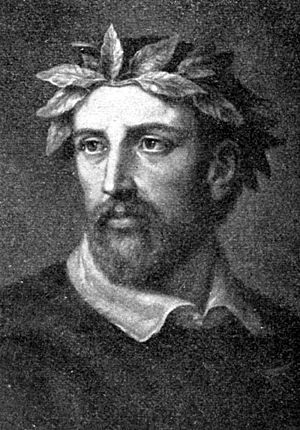Giaches de Wert facts for kids
Giaches de Wert (also known as Jacques de Wert or Giaches de Vuert) was a famous composer from the Flanders region who lived from 1535 to 1596. He spent most of his life working in Italy. He was very important in developing a type of music called the madrigal during the late Renaissance period. Many people, including the well-known composer Claudio Monteverdi, were influenced by his music. His later works also helped shape the sound of early Baroque music.
Contents
Life of Giaches de Wert
We don't know much about Giaches de Wert's early life, except that he came from Flanders. This area is now part of Belgium and the Netherlands. When he was a boy, he moved to Avellino in southern Italy. There, he became a choir boy for Maria di Cardona, a powerful noblewoman.
Maria was married to Francesco d'Este, a captain under Emperor Charles V. Francesco often traveled for military campaigns and would bring talented young musicians back to Italy. Wert's connection to the Este family lasted almost his entire life.
Before 1550, Wert also started working with the Gonzaga family. Around 1550, he likely moved to Novellara, a town in Italy, to work as a musician for a branch of the Gonzaga family. Novellara was an important music center at that time. Alfonso I, a Gonzaga, built a theater there and put on plays, with young Wert in charge of the music.
The Gonzaga and Este families were close. In the early 1550s, Wert visited Mantua and Ferrara, which were big music centers. He met Cipriano de Rore, a famous madrigal composer, who greatly influenced Wert's early music. While in Novellara, Wert married Lucrezia Gonzaga and had at least six children.
Wert stayed in Novellara until the early 1560s. Then, he became the maestro di cappella (choir director) for the main Gonzaga chapel in Milan. He didn't stay there long, moving to Mantua in 1565. In Mantua, he became the choir director at the chapel of Santa Barbara.
Wert remained the choir director in Mantua until 1592. The 1560s were busy years for him. He wrote his first four books of madrigals for five voices and his first book for four voices. He turned down other job offers, including one from the Holy Roman Emperor in Prague.
During the 1570s and 1580s, Wert became very close to the Este court in Ferrara. Even though he wasn't officially employed there, Ferrara was a very modern and forward-thinking place for music. Mantua, on the other hand, was more traditional and supported the Counter-Reformation. Ferrara's progressive ideas fit Wert's musical style better.
Wert first got sick with malaria in 1582, and he had health problems for the rest of his life. Despite this, he kept writing music. He composed a special mass for Duke Vincenzo Gonzaga in 1587. He also wrote many madrigals for the concerto delle donne, a famous group of very talented female singers in Ferrara.
In 1592, Giovanni Giacomo Gastoldi took over Wert's job as choir director in Mantua. In August 1595, Wert dedicated his last book of madrigals. He died in 1596 in Mantua, in his home near the ducal palace. His tomb is in the crypt of Santa Barbara, the church where he worked for many years.
Music and Influence
Secular Music
Giaches de Wert wrote both religious and non-religious music, plus a few instrumental pieces. But his madrigals were the most famous part of his work during his lifetime. He wrote about 230 madrigals, which were published in sixteen different books over fifty years. Most of his madrigal books were for five voices.
Wert's early music was greatly influenced by Cipriano de Rore, another famous madrigal composer. Wert's first three books show some of Rore's style, like using chromaticism (notes outside the main scale) and "word-painting." Word-painting means the music tries to show the meaning of the words. For example, if the words talk about "rising," the music might go up.
Wert also liked a style where all voices sing the same rhythm together (called homophony). He later made this style even better, influencing Monteverdi. He also liked writing for high voices, which was popular at the Este court in Ferrara. For his early works, he chose poems by famous writers like Pietro Bembo and Petrarch.
Later in his career, Wert's style changed. He started using more pure homophony. He also began to use different vocal ranges and textures instead of switching between polyphony (many independent voices) and homophony. His music became more flowing and melodic. He also started using poems by different writers, like Guarini and Torquato Tasso.
In his sixth book of madrigals (1577), he included three madrigal cycles. These were groups of madrigals that told a story or were based on a longer poem. This was a new idea at the time. These cycles were sung in a clear, speech-like way, which was a step towards monody, a style where one singer is accompanied by instruments.
When Wert met the amazing singers of the concerto delle dame in Ferrara, he started writing madrigals especially for them. These pieces had complex parts for three high voices, often with separate sections for high and low voices. The highest part usually needed the most skilled singing. His music from this time was influenced by other composers in Ferrara, like Luzzasco Luzzaschi.
In his tenth book of madrigals (1591), six pieces might have been meant for a single singer with instruments. This was similar to the early monodies that led to opera. Wert's later music sounds more like modern tonality, which was developing into the Baroque style. These later pieces were mostly homophonic, with only a few polyphonic parts for contrast. He also sometimes used the concertato style, where groups of voices sing back and forth like a dialogue.
For his last madrigal book published during his life, the eleventh, he set parts of Guarini's Il pastor fido, a very popular text for music. A final collection of Wert's music was published after he died in 1608. It included pieces for four to seven voices.
Sacred Music
Wert wrote a lot of religious music, but most of it was not published while he was alive. He only published three books of motets (religious choral pieces). A few of his works, like the Missa Dominicalis (Sunday Mass), appeared in collections with music by other composers. His other six masses and most of the music he wrote for Santa Barbara in Mantua remained as handwritten copies. This was probably because he was asked to write that music specifically for the church in Mantua.
His religious music varied in style. Some pieces were simple and homophonic, designed to make the words very clear. This followed the rules of the Council of Trent, which was part of the Counter-Reformation (Mantua was a center for this). Other motets were as emotional as his madrigals, sometimes using surprising chromaticism, similar to the composer Gesualdo. This is especially true in his 1581 collections. For example, Ascendente Jesu uses colorful "text-painting" just like his music for the Ferrara court.
Works
Secular Music: Madrigals, Canzonette
- Il primo libro de madrigali (Venice, 1558; five voices)
- Il primo libro de madrigali (Venice 1561; four voices)
- Madrigale del fiore, libro primo (Venice 1561; five voices)
- Madrigale del fiore, libro secondo (Venice 1561; five voices)
- Il terzo libro de madrigali (Venice 1563; five voices)
- Il secondo libro de madrigali (Venice 1564; five voices)
- Il quarto libro de madrigali (Venice 1567; five voices)
- Il quinto libro de madrigali (Venice 1571; five voices)
- Il sesto libro de madrigali (Venice 1577; five voices)
- Il settimo libro de madrigali (Venice 1581; five voices)
- L'ottavo libro de madrigali (Venice 1586; five voices)
- Il nono libro de madrigali (Venice 1588; five voices)
- Il primo libro delle canzonette villanelle (Venice 1589; five voices)
- Il decimo libro de madrigali (Venice 1591; five voices)
- L'undecimo libro de madrigali (Venice 1595; five voices)
- Il duodecimo libro de madrigali (Venice 1608; four to seven voices; published after his death)
- Many other works published separately or in collections, between 1558 and 1590.
Sacred Music
Most of his religious music was not published. However, these were:
- Motectorum liber primus (Venice 1566; five voices)
- Il secondo libro de motetti (Venice 1581; five voices)
- Modulationum liber primus (Venice 1581; six voices)
- Many other works published separately or in collections, between 1563 and 1609.
See also
 In Spanish: Giaches de Wert para niños
In Spanish: Giaches de Wert para niños



